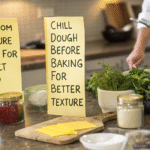Introduction
Ever taken a bite of something you just cooked and thought, “It’s okay, but it’s missing something”? You’re not alone. The truth is, many home cooks find themselves in that spot: food that looks great but falls a little flat in flavor. The good news? You don’t need a culinary degree to fix that. You just need a few simple, powerful tricks.
These aren’t complex chef techniques or expensive ingredients — they’re basic cooking hacks that anyone can use, starting today. These small changes can have a big impact, making your food more flavorful, balanced, and enjoyable. So grab your spatula, because we’re about to upgrade your kitchen game with some instantly effective tips.
1. Salt Smarter, Not Harder
Salt is the foundation of flavor, but most people use it the wrong way. Don’t just dump it in at the end — layer it as you cook.
Why It Works:
- Salting in stages (e.g., during sautéing, simmering, and finishing) builds depth.
- It brings out the natural taste of each ingredient instead of just making food salty.
Pro Tip: Use kosher or sea salt for better control and cleaner flavor.
2. Use Acid to Brighten Dull Dishes
When your food tastes bland, don’t always reach for more salt. Sometimes, what it really needs is acid.
Why It Works:
- Acid (lemon juice, vinegar, tomatoes) balances richness and intensifies flavors.
- It adds a fresh, zesty kick that instantly livens up a dish.
Pro Tip: Add a splash of lemon juice to soups, sauces, or sautéed veggies before serving.
3. Butter at the End
Finishing a dish with a pat of butter adds shine, richness, and that satisfying mouthfeel you get at restaurants.
Why It Works:
- Butter emulsifies sauces, rounds out acidity, and adds smoothness.
- A small amount can elevate everything from pasta to pan sauces.
Pro Tip: Add butter off heat to prevent it from breaking.
4. Don’t Crowd the Pan
If you’re trying to brown meat or roast vegetables, crowding them will lead to steaming, not searing.
Why It Works:
- Spacing food allows it to crisp and caramelize properly.
- Browning creates flavor (Maillard reaction), while steaming dulls it.
Pro Tip: Cook in batches if your pan isn’t big enough.
5. Fresh Herbs = Instant Flavor Boost
Fresh herbs can make any dish taste gourmet. Use them correctly, and you’ll be amazed at the difference.
Why It Works:
- Soft herbs like parsley, cilantro, basil, and dill add brightness and aroma.
- They bring a pop of color and flavor when added at the end.
Pro Tip: Chop just before using and sprinkle right before serving.
6. Sauté Onions and Garlic Properly
These two ingredients are the flavor base for countless dishes. Treat them right, and your food will thank you.
Why It Works:
- Onions need time to soften and caramelize slightly.
- Garlic burns fast, so add it last and cook just until fragrant (30 seconds).
Pro Tip: Start onions in a cold pan with oil and bring up the heat slowly.
7. Toast Your Spices
Using spices? Give them a quick toast in a dry pan or in oil before adding other ingredients.
Why It Works:
- Heat activates oils and aromas, making spices more flavorful.
- Even common spices like cumin or paprika can become deeper and richer.
Pro Tip: Only toast for 30–60 seconds. Stir constantly to avoid burning.
8. Deglaze to Capture Flavor
When food leaves brown bits (fond) in your pan, don’t scrub them off. That’s liquid gold.
Why It Works:
- Deglazing with wine, broth, or vinegar lifts the fond and creates instant pan sauces.
- It adds a restaurant-quality layer of complexity.
Pro Tip: After searing meat, splash liquid into the hot pan and scrape with a wooden spoon.
9. Let It Rest
Not just for meats. Many dishes (pasta, soups, rice) taste better after sitting for a few minutes.
Why It Works:
- Resting allows flavors to meld and moisture to redistribute.
- Food continues to cook slightly off heat, improving texture and taste.
Pro Tip: Tent meats with foil and let soups rest before serving.
10. Taste and Adjust
Your best kitchen tool is your taste buds. Recipes are guidelines, not commandments.
Why It Works:
- Tasting helps catch under-seasoning, over-spicing, or off-balance flavors.
- It gives you the control to fix things before they hit the plate.
Pro Tip: Ask yourself: Does it need salt, acid, sweetness, or richness?
Frequently Asked Questions (FAQ)
Q1: My food always tastes bland. What am I doing wrong?
A: You might be under-seasoning or skipping acid. Salt in layers and finish with lemon juice or vinegar.
Q2: Should I cook with butter or oil?
A: Use oil for high-heat cooking and butter to finish dishes or add flavor. A mix often works best.
Q3: How do I know when to use fresh herbs?
A: Add soft herbs at the end for freshness. Use woody herbs like thyme or rosemary earlier in the cooking process.
Q4: What are easy ways to fix a dish that’s too salty?
A: Add acidity (lemon juice, vinegar), sweetness (a touch of sugar), or bulk (more rice/pasta/water).
Q5: Do these tricks work for vegetarian and vegan meals too?
A: Absolutely. All these tips enhance plant-based meals just as well.
Conclusion
Great cooking isn’t always about following complicated recipes or using rare ingredients. Sometimes, it’s just knowing when to add a splash of lemon, how to brown mushrooms properly, or why letting soup rest makes all the difference.
These basic cooking tricks are small but mighty. They can instantly elevate your meals and make your everyday cooking feel more rewarding and delicious. Whether you’re cooking for yourself, your family, or guests, these tips help you bring out the best in every dish.
So next time something tastes “meh,” don’t toss it out — tweak it. You now know the tricks. And with practice, those tricks will become instincts.


